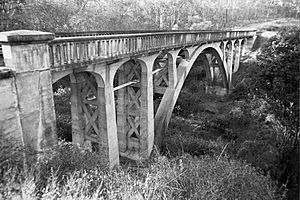Lockyer Creek Railway Bridge (Lockyer) facts for kids
Quick facts for kids Lockyer Creek Railway Bridge (Lockyer) |
|
|---|---|

Lockyer Creek Railway Bridge at Lockyer
|
|
| Location | Toowoomba - Helidon Line over Lockyer Creek at Lockyer, Lockyer Valley Region, Queensland, Australia |
| Design period | 1900 - 1914 (early 20th century) |
| Built | 1909 - 1910 |
| Architect | William Pagan |
| Official name: Lockyer Creek Railway Bridge (Lockyer) | |
| Type | state heritage (built) |
| Designated | 21 October 1992 |
| Reference no. | 600513 |
| Significant period | 1900s (fabric) |
| Significant components | abutments - railway bridge, pier/s (bridge) |
| Lua error in Module:Location_map at line 420: attempt to index field 'wikibase' (a nil value). | |
The Lockyer Creek Railway Bridge is a special old railway bridge in Lockyer, Australia. It crosses over Lockyer Creek. This bridge was built a long time ago, between 1909 and 1910. A clever engineer named William Pagan designed it. Today, it is listed on the Queensland Heritage Register. This means it's an important historical place.
Contents
Building a Railway Bridge: A Look at Its History
This bridge was finished in 1910. It was part of the main railway line that connected Brisbane to Toowoomba. It was one of three railway bridges built across Lockyer Creek.
Why Was This Bridge Built?
The railway line between Helidon and Toowoomba opened in 1867. From the 1870s, people worked to make the main railway line better. It was a very important route. Older bridges needed to be replaced to carry heavier trains. So, in 1908, work started on a new bridge. This new bridge would cross a part of Lockyer Creek.
Who Designed This Bridge?
The plans for this new bridge were finished in 1909. They were signed by the Chief Engineer, William Pagan. The bridge and a new section of the railway opened on 18 July 1910.
Concrete Bridges in Queensland
Using concrete arches for railway bridges was special in Queensland. The first concrete bridge in Queensland was built in 1897. Between 1900 and 1913, six concrete arch railway bridges were built. William Pagan was the Chief Engineer during this time. He likely designed them all.
The Lockyer Creek bridge was only the second bridge of its kind in Australia. It was built using a special type of concrete called "reinforced concrete." This makes it very strong. Its main section stretches about 27.4 meters. This was one of the longest spans for an arch bridge in Australia at that time.
What Does the Bridge Look Like?
The Lockyer Creek Railway Bridge crosses a dry valley. It is about 1 kilometer south of Lockyer. It's a concrete arch bridge that curves slightly. It carries a single railway track.
Key Parts of the Bridge
The bridge has several sections:
- Two smaller reinforced concrete arches, each about 4.3 meters long.
- A large reinforced concrete arch, about 27.4 meters long. This big arch supports smaller arches on top.
- Two more smaller reinforced concrete arches, each about 4.3 meters long.
The bridge also has concrete columns arranged in pairs. These columns help support the arches. The arches themselves are shaped like a parabola. This shape helps distribute the weight. There is also a concrete fence along the top. The entire bridge was built using concrete poured into molds.
Why Is This Bridge Important?
The Lockyer Creek Railway Bridge is listed on the Queensland Heritage Register. This means it is important to Queensland's history. It was added to the list on 21 October 1992.
Showing How Queensland Grew
This bridge shows how railways developed in Queensland. It's an example of how this important railway line was updated. It helped meet the needs of the early 1900s. It also shows how engineers used technology to build bridges in tough places.
A Beautiful and Useful Design
The bridge looks nice and works well. Its arches create a beautiful contrast with the plants around it.
A Great Engineering Achievement
This bridge was built with a very new design for its time. It was only the second reinforced concrete arch bridge designed in Australia. It's special because it has two separate arch ribs. It also has unique concrete columns that are braced together.
Connected to an Important Engineer
The bridge is an important example of the work of William Pagan. He was the Chief Engineer for Railways. He played a big role in the early history of engineering in Queensland.

